Dell Latitude 5590 User Manual

Latitude 5590
Owners Manual
Regulatory Model: P60F
Regulatory Type: P60F002
Notes, cautions, and warnings

 NOTE: A NOTE indicates important information that helps you make better use of your product.
NOTE: A NOTE indicates important information that helps you make better use of your product.

 CAUTION: A CAUTION indicates either potential damage to hardware or loss of data and tells you how to avoid the problem.
CAUTION: A CAUTION indicates either potential damage to hardware or loss of data and tells you how to avoid the problem. 
 WARNING: A WARNING indicates a potential for property damage, personal injury, or death.
WARNING: A WARNING indicates a potential for property damage, personal injury, or death.
© 2016 Dell Inc. or its subsidiaries. All rights reserved. This product is protected by U.S. and international copyright and intellectual property laws. Dell and the Dell logo are trademarks of Dell Inc. in the United States and/or other jurisdictions. All other marks and names mentioned herein may be trademarks of their respective companies.
2018 - 01
Rev. A00

Contents
1 Working on your computer............................................................................................................................. |
7 |
Safety precautions............................................................................................................................................................. |
7 |
Standby power.............................................................................................................................................................. |
7 |
Bonding ......................................................................................................................................................................... |
7 |
Electrostatic discharge — ESD protection............................................................................................................... |
7 |
ESD •eld service kit .................................................................................................................................................... |
8 |
Transporting sensitive components........................................................................................................................... |
9 |
Before working inside your computer.............................................................................................................................. |
9 |
After working inside your computer................................................................................................................................. |
9 |
2 Removing and installing components............................................................................................................ |
11 |
Removing and installing components.............................................................................................................................. |
11 |
Recommended tools................................................................................................................................................... |
11 |
Screw size list.............................................................................................................................................................. |
11 |
Subscriber Identity Module(SIM) board.................................................................................................................. |
12 |
Base cover................................................................................................................................................................... |
13 |
Battery......................................................................................................................................................................... |
14 |
Solid State Drive — optional .................................................................................................................................... |
15 |
Hard drive.................................................................................................................................................................... |
17 |
WLAN card.................................................................................................................................................................. |
19 |
WWAN card................................................................................................................................................................ |
20 |
Coin cell battery......................................................................................................................................................... |
22 |
Memory modules........................................................................................................................................................ |
23 |
Keyboard..................................................................................................................................................................... |
24 |
Heat sink ..................................................................................................................................................................... |
27 |
System fan.................................................................................................................................................................. |
28 |
Power connector port............................................................................................................................................... |
29 |
Chassis frame............................................................................................................................................................. |
30 |
System board.............................................................................................................................................................. |
32 |
Touchpad buttons board........................................................................................................................................... |
35 |
SmartCard module..................................................................................................................................................... |
37 |
LED board................................................................................................................................................................... |
39 |
Speaker........................................................................................................................................................................ |
41 |
Hinge cap.................................................................................................................................................................... |
42 |
Display assembly........................................................................................................................................................ |
43 |
Display bezel................................................................................................................................................................ |
47 |
Display hinges............................................................................................................................................................. |
48 |
Display panel............................................................................................................................................................... |
50 |
Display (eDP) cable.................................................................................................................................................... |
52 |
Camera........................................................................................................................................................................ |
53 |
Display back cover assembly.................................................................................................................................... |
54 |
Palm rest..................................................................................................................................................................... |
55 |
Contents |
3 |

|
3 Technology and components........................................................................................................................ |
57 |
|
Power adapter.................................................................................................................................................................. |
57 |
|
Processors........................................................................................................................................................................ |
57 |
|
Kaby Lake — 7th Generation Intel Core processors............................................................................................. |
57 |
|
Kaby Lake — 8th Generation Intel Core processors............................................................................................. |
58 |
|
Identifying processors in Windows 10..................................................................................................................... |
59 |
|
Verifying the processor usage in Task Manager.................................................................................................... |
59 |
|
Verifying the processor usage in Resource Monitor.............................................................................................. |
60 |
|
Chipsets............................................................................................................................................................................ |
60 |
|
Identifying the chipset in Device Manager on Windows 10................................................................................... |
61 |
|
Memory features.............................................................................................................................................................. |
61 |
|
Verifying system memory in Windows 10................................................................................................................ |
61 |
|
Verifying system memory in system setup BIOS.................................................................................................... |
61 |
|
Testing memory using ePSA...................................................................................................................................... |
61 |
|
DDR4........................................................................................................................................................................... |
62 |
|
Graphic options................................................................................................................................................................ |
63 |
|
Display options.................................................................................................................................................................. |
63 |
|
Identifying the display adapter................................................................................................................................. |
63 |
|
Changing the screen resolution................................................................................................................................ |
63 |
|
Rotating the display................................................................................................................................................... |
64 |
|
Adjusting brightness in Windows 10........................................................................................................................ |
64 |
|
Cleaning the display................................................................................................................................................... |
64 |
|
Using touch screen in Windows 10.......................................................................................................................... |
65 |
|
Connecting to external display devices................................................................................................................... |
65 |
|
Hard drive options............................................................................................................................................................ |
65 |
|
Identifying the hard drive in Windows 10................................................................................................................ |
65 |
|
Identifying the hard drive in the BIOS..................................................................................................................... |
65 |
|
USB features.................................................................................................................................................................... |
66 |
|
USB 3.0/USB 3.1 Gen 1 (SuperSpeed USB)........................................................................................................... |
66 |
|
Speed.......................................................................................................................................................................... |
66 |
|
Applications................................................................................................................................................................. |
67 |
|
Compatibility............................................................................................................................................................... |
68 |
|
HDMI 1.4- HDMI 2.0........................................................................................................................................................ |
68 |
|
HDMI 1.4- HDMI 2.0 Features.................................................................................................................................. |
68 |
|
Advantages of HDMI................................................................................................................................................. |
68 |
|
Realtek ALC3246 Waves MaxxAudio Pro controller.................................................................................................... |
69 |
|
Downloading the audio driver................................................................................................................................... |
69 |
|
Identifying the audio controller in Windows 10....................................................................................................... |
69 |
|
Changing the audio settings..................................................................................................................................... |
69 |
|
Realtek HD audio drivers........................................................................................................................................... |
69 |
|
WLAN cards...................................................................................................................................................................... |
70 |
|
Secure Boot screen options...................................................................................................................................... |
70 |
|
Camera features............................................................................................................................................................... |
70 |
|
Identifying the camera in Device Manager on Windows 10................................................................................... |
71 |
|
Starting the camera application................................................................................................................................ |
71 |
4 |
Contents |
|

4 System speci€cations.................................................................................................................................. |
73 |
Technical speci•cations................................................................................................................................................... |
73 |
System speci•cations................................................................................................................................................ |
73 |
Processor speci•cations............................................................................................................................................ |
73 |
Memory speci•cations.............................................................................................................................................. |
73 |
Storage speci•cations................................................................................................................................................ |
74 |
Audio speci•cations................................................................................................................................................... |
74 |
Video speci•cations................................................................................................................................................... |
74 |
Camera speci•cations............................................................................................................................................... |
75 |
Communication speci•cations.................................................................................................................................. |
75 |
Port and connector speci•cations........................................................................................................................... |
75 |
Contactless smart card speci•cations..................................................................................................................... |
76 |
Display speci•cations................................................................................................................................................. |
76 |
Keyboard speci•cations............................................................................................................................................. |
77 |
Touchpad speci•cations............................................................................................................................................ |
77 |
Battery speci•cations................................................................................................................................................ |
77 |
AC Adapter speci•cations......................................................................................................................................... |
78 |
Physical speci•cations............................................................................................................................................... |
78 |
Environmental speci•cations.................................................................................................................................... |
79 |
5 System setup options.................................................................................................................................. |
80 |
Boot Sequence................................................................................................................................................................. |
80 |
Navigation keys................................................................................................................................................................. |
81 |
System Setup overview................................................................................................................................................... |
81 |
Accessing System Setup................................................................................................................................................. |
81 |
General screen options..................................................................................................................................................... |
81 |
System Con•guration screen options............................................................................................................................ |
82 |
Video screen options....................................................................................................................................................... |
85 |
Security screen options................................................................................................................................................... |
85 |
Secure Boot screen options............................................................................................................................................ |
87 |
Intel Software Guard Extensions.................................................................................................................................... |
87 |
Performance screen options.......................................................................................................................................... |
88 |
Power Management screen options.............................................................................................................................. |
88 |
POST Behavior screen options...................................................................................................................................... |
90 |
Virtualization support screen options............................................................................................................................. |
91 |
Wireless screen options................................................................................................................................................... |
91 |
Maintenance screen options........................................................................................................................................... |
92 |
System Log screen options............................................................................................................................................. |
92 |
Updating the BIOS in Windows ..................................................................................................................................... |
92 |
System and setup password........................................................................................................................................... |
93 |
Assigning a system password and setup password............................................................................................... |
93 |
Deleting or changing an existing system and or setup password........................................................................ |
93 |
6 Software...................................................................................................................................................... |
95 |
Supported operating systems........................................................................................................................................ |
95 |
Downloading drivers........................................................................................................................................................ |
95 |
Contents |
5 |

Downloading the chipset driver..................................................................................................................................... |
95 |
Intel chipset drivers.......................................................................................................................................................... |
96 |
Intel HD Graphics drivers................................................................................................................................................ |
96 |
7 Troubleshooting............................................................................................................................................ |
97 |
Enhanced Pre-Boot System Assessment — ePSA diagnostics................................................................................ |
97 |
Running the ePSA diagnostics................................................................................................................................. |
97 |
Real Time Clock reset...................................................................................................................................................... |
97 |
8 Contacting Dell............................................................................................................................................ |
99 |
6 Contents

1
Working on your computer
Safety precautions
The safety precautions chapter details the primary steps to be taken before performing any disassembly instructions.
Observe the following safety precautions before you perform any installation or break/•x procedures involving disassembly or reassembly:
•Turn oƒ the system and all attached peripherals.
•Disconnect the system and all attached peripherals from AC power.
•Disconnect all network cables, telephone, and telecommunications lines from the system.
•Use an ESD •eld service kit when working inside any notebook to avoid electrostatic discharge (ESD) damage.
•After removing any system component, carefully place the removed component on an anti-static mat.
•Wear shoes with non-conductive rubber soles to reduce the chance of getting electrocuted.
Standby power
Dell products with standby power must be unplugged before you open the case. Systems that incorporate standby power are essentially powered while turned oƒ. The internal power enables the system to be remotely turned on (wake on LAN) and suspended into a sleep mode and has other advanced power management features.
Unplugging, pressing and holding the power button for 15 seconds should discharge residual power in the system board, notebooks
Bonding
Bonding is a method for connecting two or more grounding conductors to the same electrical potential. This is done through the use of a •eld service electrostatic discharge (ESD) kit. When connecting a bonding wire, ensure that it is connected to bare metal and never to a painted or non-metal surface. The wrist strap should be secure and in full contact with your skin, and ensure that you remove all jewelry such as watches, bracelets, or rings prior to bonding yourself and the equipment.
Electrostatic discharge — ESD protection
ESD is a major concern when you handle electronic components, especially sensitive components such as expansion cards, processors, memory DIMMs, and system boards. Very slight charges can damage circuits in ways that may not be obvious, such as intermittent problems or a shortened product life span. As the industry pushes for lower power requirements and increased density, ESD protection is an increasing concern.
Due to the increased density of semiconductors used in recent Dell products, the sensitivity to static damage is now higher than in previous Dell products. For this reason, some previously approved methods of handling parts are no longer applicable.
Two recognized types of ESD damage are catastrophic and intermittent failures.
•Catastrophic – Catastrophic failures represent approximately 20 percent of ESD-related failures. The damage causes an immediate and complete loss of device functionality. An example of catastrophic failure is a memory DIMM that has received a static shock and immediately generates a "No POST/No Video" symptom with a beep code emitted for missing or nonfunctional memory.
•Intermittent – Intermittent failures represent approximately 80 percent of ESD-related failures. The high rate of intermittent failures means that most of the time when damage occurs, it is not immediately recognizable. The DIMM receives a static shock, but the
Working on your computer |
7 |
|
|

tracing is merely weakened and does not immediately produce outward symptoms related to the damage. The weakened trace may take weeks or months to melt, and in the meantime may cause degradation of memory integrity, intermittent memory errors, etc.
The more difficult type of damage to recognize and troubleshoot is the intermittent (also called latent or "walking wounded") failure.
Perform the following steps to prevent ESD damage:
•Use a wired ESD wrist strap that is properly grounded. The use of wireless anti-static straps is no longer allowed; they do not provide adequate protection. Touching the chassis before handling parts does not ensure adequate ESD protection on parts with increased sensitivity to ESD damage.
•Handle all static-sensitive components in a static-safe area. If possible, use anti-static floor pads and workbench pads.
•When unpacking a static-sensitive component from its shipping carton, do not remove the component from the anti-static packing material until you are ready to install the component. Before unwrapping the anti-static packaging, ensure that you discharge static electricity from your body.
•Before transporting a static-sensitive component, place it in an anti-static container or packaging.
ESD €eld service kit
The unmonitored Field Service kit is the most commonly used service kit. Each Field Service kit includes three main components: anti-static mat, wrist strap, and bonding wire.
Components of an ESD €eld service kit
The components of an ESD •eld service kit are:
•Anti-Static Mat – The anti-static mat is dissipative and parts can be placed on it during service procedures. When using an anti-static mat, your wrist strap should be snug and the bonding wire should be connected to the mat and to any bare metal on the system being worked on. Once deployed properly, service parts can be removed from the ESD bag and placed directly on the mat. ESD-sensitive items are safe in your hand, on the ESD mat, in the system, or inside a bag.
•Wrist Strap and Bonding Wire – The wrist strap and bonding wire can be either directly connected between your wrist and bare metal on the hardware if the ESD mat is not required, or connected to the anti-static mat to protect hardware that is temporarily placed on the mat. The physical connection of the wrist strap and bonding wire between your skin, the ESD mat, and the hardware is known as bonding. Use only Field Service kits with a wrist strap, mat, and bonding wire. Never use wireless wrist straps. Always be aware that the internal wires of a wrist strap are prone to damage from normal wear and tear, and must be checked regularly with a wrist strap tester in order to avoid accidental ESD hardware damage. It is recommended to test the wrist strap and bonding wire at least once per week.
•ESD Wrist Strap Tester – The wires inside of an ESD strap are prone to damage over time. When using an unmonitored kit, it is a best practice to regularly test the strap prior to each service call, and at a minimum, test once per week. A wrist strap tester is the best method for doing this test. If you do not have your own wrist strap tester, check with your regional office to •nd out if they have one. To perform the test, plug the wrist-strap's bonding-wire into the tester while it is strapped to your wrist and push the button to test. A green LED is lit if the test is successful; a red LED is lit and an alarm sounds if the test fails.
•Insulator Elements – It is critical to keep ESD sensitive devices, such as plastic heat sink casings, away from internal parts that are insulators and often highly charged.
•Working Environment – Before deploying the ESD Field Service kit, assess the situation at the customer location. For example, deploying the kit for a server environment is diƒerent than for a desktop or portable environment. Servers are typically installed in a rack within a data center; desktops or portables are typically placed on office desks or cubicles. Always look for a large open flat work area that is free of clutter and large enough to deploy the ESD kit with additional space to accommodate the type of system that is being repaired. The workspace should also be free of insulators that can cause an ESD event. On the work area, insulators such as Styrofoam and other plastics should always be moved at least 12 inches or 30 centimeters away from sensitive parts before physically handling any hardware components
•ESD Packaging – All ESD-sensitive devices must be shipped and received in static-safe packaging. Metal, static-shielded bags are preferred. However, you should always return the damaged part using the same ESD bag and packaging that the new part arrived in. The ESD bag should be folded over and taped shut and all the same foam packing material should be used in the original box that the new part arrived in. ESD-sensitive devices should be removed from packaging only at an ESD-protected work surface, and parts should never be placed on top of the ESD bag because only the inside of the bag is shielded. Always place parts in your hand, on the ESD mat, in the system, or inside an anti-static bag.
•Transporting Sensitive Components – When transporting ESD sensitive components such as replacement parts or parts to be returned to Dell, it is critical to place these parts in anti-static bags for safe transport.
8 Working on your computer

ESD protection summary
It is recommended that all •eld service technicians use the traditional wired ESD grounding wrist strap and protective anti-static mat at all times when servicing Dell products. In addition, it is critical that technicians keep sensitive parts separate from all insulator parts while performing service and that they use anti-static bags for transporting sensitive components.
Transporting sensitive components
When transporting ESD sensitive components such as replacement parts or parts to be returned to Dell, it is critical to place these parts in anti-static bags for safe transport.
Lifting equipment
Adhere to the following guidelines when lifting heavy weight equipment:

 CAUTION: Do not lift greater than 50 pounds. Always obtain additional resources or use a mechanical lifting device.
CAUTION: Do not lift greater than 50 pounds. Always obtain additional resources or use a mechanical lifting device.
1Get a •rm balanced footing. Keep your feet apart for a stable base, and point your toes out.
2Tighten stomach muscles. Abdominal muscles support your spine when you lift, oƒsetting the force of the load.
3Lift with your legs, not your back.
4Keep the load close. The closer it is to your spine, the less force it exerts on your back.
5Keep your back upright, whether lifting or setting down the load. Do not add the weight of your body to the load. Avoid twisting your body and back.
6Follow the same techniques in reverse to set the load down.
Before working inside your computer
1Ensure that your work surface is flat and clean to prevent the computer cover from being scratched.
2Turn oƒ your computer.
3If the computer is connected to a docking device (docked), undock it.
4Disconnect all network cables from the computer (if available).
CAUTION: If your computer has an RJ45 port, disconnect the network cable by €rst unplugging the cable from your computer.
5Disconnect your computer and all attached devices from their electrical outlets.
6Open the display.
7Press and hold the power button for few seconds, to ground the system board.

 CAUTION: To guard against electrical shock unplug your computer from the electrical outlet before performing Step # 8.
CAUTION: To guard against electrical shock unplug your computer from the electrical outlet before performing Step # 8.
CAUTION: To avoid electrostatic discharge, ground yourself by using a wrist grounding strap or by periodically touching an unpainted metal surface at the same time as touching a connector on the back of the computer.
8 Remove any installed ExpressCards or Smart Cards from the appropriate slots.
After working inside your computer
After you complete any replacement procedure, ensure you connect any external devices, cards, and cables before turning on your computer.
Working on your computer |
9 |
|
|

CAUTION: To avoid damage to the computer, use only the battery designed for this particular Dell computer. Do not use batteries designed for other Dell computers.
1Replace the battery.
2Replace the base cover.
3Connect any external devices, such as a port replicator or media base, and replace any cards, such as an ExpressCard.
4Connect any telephone or network cables to your computer.
CAUTION: To connect a network cable, €rst plug the cable into the network device and then plug it into the computer.
5Connect your computer and all attached devices to their electrical outlets.
6Turn on your computer.
10 Working on your computer

2
Removing and installing components
This section provides detailed information on how to remove or install the components from your computer.
Removing and installing components
This section provides detailed information on how to remove or install the components from your computer.
Recommended tools
The procedures in this document require the following tools:
•Phillips #0 screwdriver
•Phillips #1 screwdriver
•Plastic scribe

 NOTE: The #0 screw driver is for screws 0-1 and the #1 screw driver is for screws 2-4
NOTE: The #0 screw driver is for screws 0-1 and the #1 screw driver is for screws 2-4
Screw size list
Table 1.
Component |
M2.0x3.0 |
M2.5x3.5 |
M2.5x5.0 |
M2.0x2.5 |
M2x3.0 |
M2x5 |
|
||
(OD4.5) |
|
||||||||
|
|
|
|
|
|
|
|
|
|
|
|
|
|
|
|
|
|
|
|
Base cover |
|
|
8 |
|
|
|
|
|
|
|
|
|
|
|
|
|
|
|
|
Battery |
|
|
1 |
|
|
|
|
|
|
|
|
|
|
|
|
|
|
|
|
Soild State Drive |
1 |
|
|
|
|
|
|
|
|
|
|
|
|
|
|
|
|
|
|
SSD frame |
1 |
|
|
|
|
|
|
|
|
|
|
|
|
|
|
|
|
|
|
WLAN card |
1 |
|
|
|
|
|
|
|
|
|
|
|
|
|
|
|
|
|
|
Keyboard |
|
|
|
6 |
|
|
|
|
|
|
|
|
|
|
|
|
|
|
|
Heat sink |
4 |
|
|
|
|
|
|
|
|
|
|
|
|
|
|
|
|
|
|
System board |
3 |
|
|
|
|
3 |
|
|
|
|
|
|
|
|
|
|
|
|
|
Power connector |
1 |
|
|
|
|
|
|
|
|
|
|
|
|
|
|
|
|
|
|
Chassis frame |
5 |
|
|
|
|
2 |
|
|
|
|
|
|
|
|
|
|
|
|
|
Smart card reader |
2 |
|
|
|
|
|
|
|
|
|
|
|
|
|
|
|
|
|
|
Touchpad panel |
2 |
|
|
|
|
|
|
|
|
|
|
|
|
|
|
|
|
|
|
LED board |
1 |
|
|
|
|
|
|
|
|
|
|
|
|
|
|
|
|
|
|
Hinge cap |
|
|
|
|
2 |
|
|
|
|
|
|
|
|
|
|
|
|
|
|
Display assembly |
|
|
|
|
|
6 |
|
|
|
|
|
|
|
|
|
|
|
|
|
|
|
|
|
Removing and installing components |
|
|
11 |
||
|
|
|
|
|
|||||
|
|
|
|
|
|
|
|
|
|
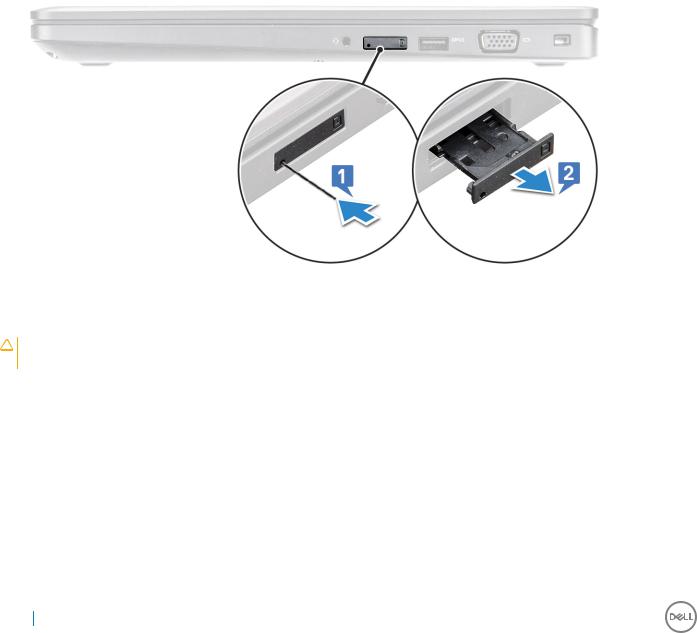
Component |
M2.0x3.0 |
M2.5x3.5 |
M2.5x5.0 |
M2.0x2.5 |
M2x3.0 |
M2x5 |
|
(OD4.5) |
|||||||
|
|
|
|
|
|
||
|
|
|
|
|
|
|
|
Hinge |
|
6 |
|
|
|
|
|
|
|
|
|
|
|
|
|
Display panel |
4 |
|
|
|
|
|
|
|
|
|
|
|
|
|
|
Hard drive |
|
|
|
|
|
4 |
|
|
|
|
|
|
|
|
|
WWAN |
1 |
|
|
|
|
|
|
|
|
|
|
|
|
|
Subscriber Identity Module(SIM) board
Installing the Subscriber Identi€cation Module card
1Insert a paperclip or a Subscriber Identi•cation Module (SIM) card removal tool into the pinhole [1].
2Pull the SIM card tray to remove it [2].
3Place the SIM on the SIM card tray.
4Push the SIM card tray into the slot until it clicks into place.
Removing the Subscriber Identi€cation Module card
CAUTION: Removing the Subscriber Identi€cation Module (SIM) card when the computer is on may cause data loss or damage the card. Ensure your computer is turned o‚ or the network connections are disabled.
1Insert a paperclip or a SIM card removal tool into the pinhole on the SIM card tray.
2Pull the SIM card tray to remove it.
3Remove the SIM card from the SIM card tray.
4Push the SIM card tray into the slot until it clicks into place.
12 Removing and installing components
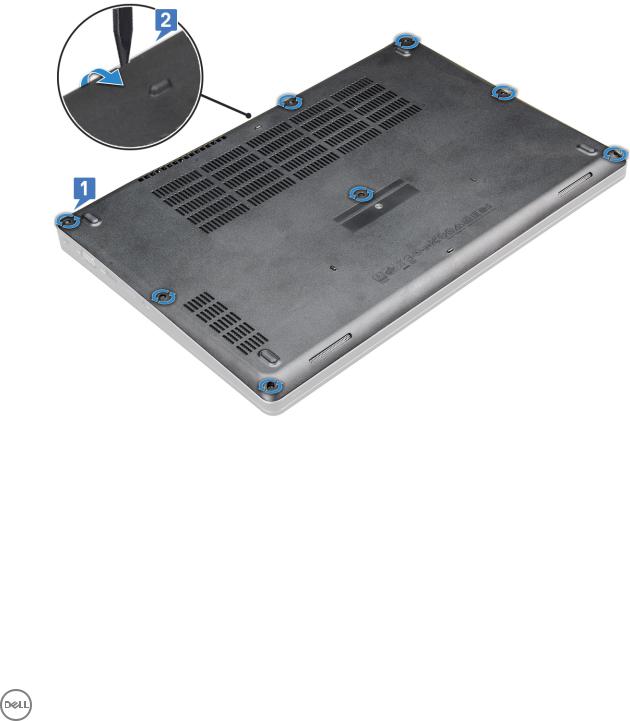
Base cover
Removing the base cover
1Follow the procedure in Before working inside your computer.
2To remove the base cover:
aLoosen the M2x5 (8) captive screws that secure the base cover to the laptop [1].
bPry the base cover from the edge [2].

 NOTE: Ensure to use a plastic scribe to pry the base cover from the edge.
NOTE: Ensure to use a plastic scribe to pry the base cover from the edge.
3 Lift the base cover away from the laptop.
Removing and installing components |
13 |
|
|
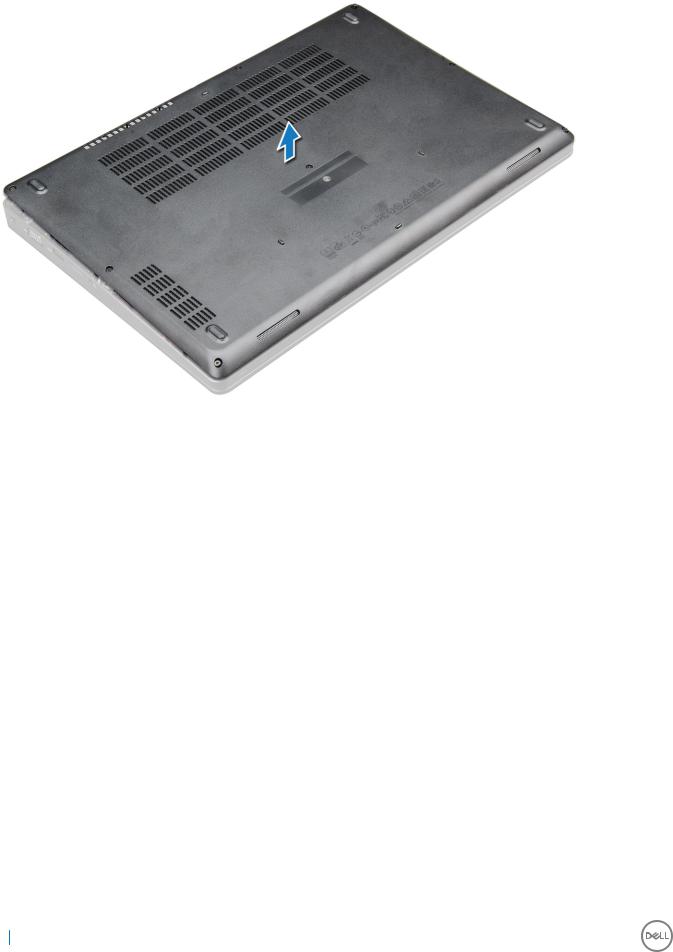
Installing the base cover
1Align the base cover with the screw holders on the laptop .
2Press the edges of the cover until it clicks into place.
3Tighten the M2x5 screws to secure the base cover to the laptop.
4Follow the procedure in After working inside your computer.
Battery
Removing the battery

 NOTE: A 4-cell 68Whr battery has only 1 screw.
NOTE: A 4-cell 68Whr battery has only 1 screw.
1Follow the procedure in Before working inside your computer.
2Remove the base cover.
3To remove the battery:
aDisconnect the battery cable from the connector on the system board [1].
bLoosen the M2x5 screw (1) that secure the battery to the laptop [2].
cLift the battery away from the laptop chassis [3].
14 Removing and installing components

Installing the battery

 NOTE: 68Whr battery can use either a M.2 or 7mm SATA drive.
NOTE: 68Whr battery can use either a M.2 or 7mm SATA drive.
1 Insert the battery into the slot on the laptop.

 NOTE: Wrap the battery cable below the battery routing channel to enable proper connection to the connector.
NOTE: Wrap the battery cable below the battery routing channel to enable proper connection to the connector.
2Connect the battery cable to the connector on the system board.
3Tighten the M2x5 screw to secure the battery to the laptop.
4Install the base cover.
5Follow the procedure in After working inside your computer.
Solid State Drive — optional
Removing the M.2 Solid State Drive - SSD
1Follow the procedure in Before working inside your computer.
2Remove the:
abase cover
bbattery
3 To remove the SSD:
aRemove the M2.0x3.0 screw (1) that secures the SSD bracket to the laptop and lift the SSD bracket that secures the SSD card to the system board [1],[2] .
Removing and installing components |
15 |
|
|
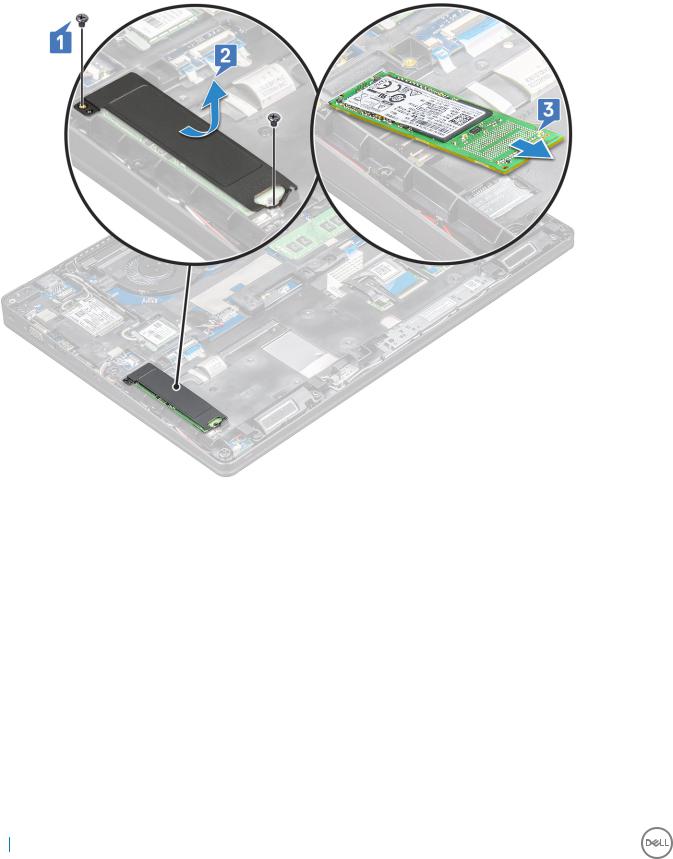

 NOTE: System shipped with NVMe SSDs, the SSD do not require removal of mylar shield.
NOTE: System shipped with NVMe SSDs, the SSD do not require removal of mylar shield.
bRemove the SSD screw (1) that secures the SSD card to the system board .
cLift and pull the SSD card from the laptop [3].

 NOTE: For models shipped with NVMe SSDs, remove the thermal plate placed over the SSD.
NOTE: For models shipped with NVMe SSDs, remove the thermal plate placed over the SSD.
4 To remove the SSD clip:
aRemove the M2.0x3.0 screw that secures the SSD clip to the laptop [1].
bLift the SSD clip away from the laptop [2].
16 Removing and installing components

Installing the M.2 Solid State Drive - SSD

 NOTE: Before installing SSD card, ensure that the battery is fully charged or the power cable is plugged in.
NOTE: Before installing SSD card, ensure that the battery is fully charged or the power cable is plugged in.
1Place the SSD clip on the laptop.
2Tighten the M2.0x3.0 screw that secures SSD clip to the laptop.
3Insert the SSD into the socket on the laptop.
4Place the SSD bracket and tighten the M2.0x3.0 screw (2) to secure the SSD to the laptop.
5Install the:
abattery
bbase cover
6 Follow the procedure in After working inside your computer.
Hard drive
Removing hard drive
1Follow the procedure in Before working inside your computer.
2Remove the base cover.
3Do not remove the battery, instead disconnect the battery cable from the system board.
4To remove the hard drive:
a Disconnect the hard drive cable from the connector on the system board [1].
Removing and installing components |
17 |
|
|

NOTE: The system default con€guration is HDD. The laptop is either shipped with HDD or SDD.
b Remove the M2 x 2.7+2.7 screws (4) that secure the hard drive to the system [2].
5 Lift the hard drive away from the system.
18 Removing and installing components

Installing hard drive
1Insert the hard drive into the slot on the system.
2Replace the screws to secure the hard drive to the system.
3Replace the hard drive cable.
4Replace the screws to secure the hard drive assembly to the system.
5Connect the hard drive cable to the connector on the system board.
6If you have not removed the battery, you must connect the battery cable to the system board.
7Install the base cover.
8Follow the procedures in After working inside your system.
WLAN card
Removing the WLAN card
1Follow the procedure in Before working inside your computer.
2Remove the:
abase cover
bbattery
3 To remove the WLAN card:
aRemove the M2.0x3.0 screw (1) that secures the WLAN card to the laptop [1].
bLift the metal bracket that secures the WLAN cables to the WLAN card [2].
cDisconnect the WLAN cables from the connectors on the WLAN card [3].

 NOTE: The WLAN card is held in place with an adhesive foam spacer. d Pull the WLAN card to release it from the connector on the system board[4].
NOTE: The WLAN card is held in place with an adhesive foam spacer. d Pull the WLAN card to release it from the connector on the system board[4].

 NOTE: Ensure NOT to pull the WLAN card more than 35°, to avoid pin damage.
NOTE: Ensure NOT to pull the WLAN card more than 35°, to avoid pin damage.
Removing and installing components |
19 |
|
|

Installing the WLAN card
1Insert the WLAN card into the slot on the laptop.
2Route the WLAN cables through the routing channel.
3Connect the WLAN cables to the connectors on the WLAN Card.
4Place the metal bracket and tighten the M2.0x3.0 screw to secures the WLAN card to the system board.
5Install the:
abattery
bbase cover
6 Follow the procedure in After working inside your system.
WWAN card
Removing WWAN card
1Follow the procedure in Before working inside your computer.
2Remove the:
abase cover
bbattery
3 To remove the WWAN card:
a Remove the M2.0 x 3.0 screw (1) that secures the metal bracket to the WWAN card [1].
20 Removing and installing components


 NOTE: Do not pull the WWAN card more than 35°, to avoid pin damage.
NOTE: Do not pull the WWAN card more than 35°, to avoid pin damage.
bLift the metal bracket that secures the WWAN card to the system board [2].
cDisconnect the WWAN cables from the connectors on the WWAN card with a plastic scribe.[3].

 NOTE: Do press the WWAN card, and then release the cables from the connectors.
NOTE: Do press the WWAN card, and then release the cables from the connectors.
dPull the WWAN card to release it from the connector on the system board [4].

 NOTE: Do not lift the WWAN card by an angle more than 35°.
NOTE: Do not lift the WWAN card by an angle more than 35°.
Installing the WWAN card
1Insert the WWAN card into the slot on the laptop.
2Connect the WWAN cables to the connectors on the WWAN card.
3Place the metal bracket and tighten the M2.0 x 3.0 screw to secure it to the laptop.
4Install the:
abattery
bbase cover
5 Follow the procedure in After working inside your system.
Removing and installing components |
21 |
|
|
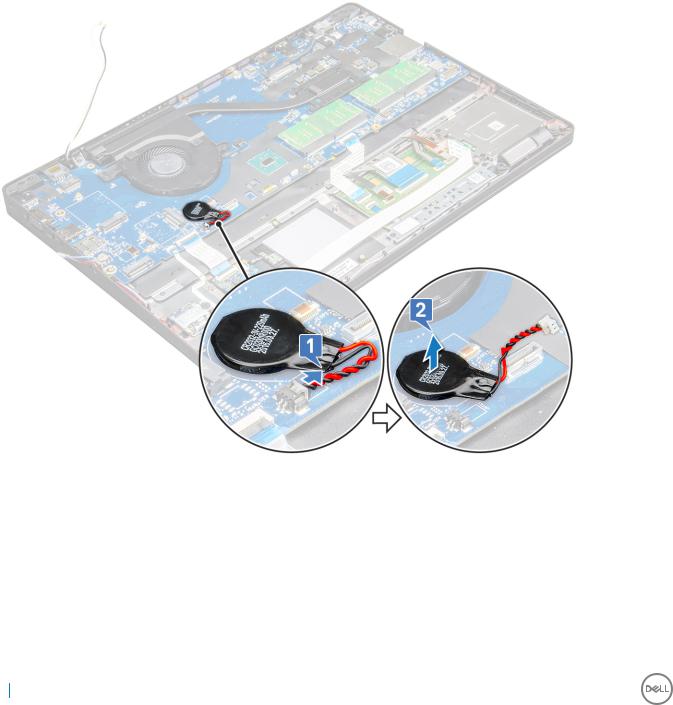
Coin cell battery
Removing the coin cell battery
1Follow the procedure in Before working inside your computer.
2Remove the:
abase cover
bbattery
3 To remove the coin cell battery:
aDisconnect the coin cell battery cable from the connector on the system board [1].
bPry the coin cell battery to release from the adhesive and lift it away from the system board [2].
Installing the coin cell battery
1Place the coin cell battery on the system board.
2Connect the coin cell battery cable to the connector on the system board.

 NOTE: Route the coin cell battery cable carefully to avoid damaging the cable.
NOTE: Route the coin cell battery cable carefully to avoid damaging the cable.
3 Install the:
abattery
bbase cover
4 Follow the procedure in After working inside your computer.
22 Removing and installing components

Memory modules
Removing the memory module
1Follow the procedure in Before working inside your computer.
2Remove the:
abase cover
bbattery
3 To remove the memory module:
aPress the clips securing the memory module until the memory pops-up [1].
bPull the memory module from the connector on the system board [2].
Installing the memory module
1 Insert the memory module into the memory module socket until the clips secure the memory module.
NOTE: Ensure to insert the memory module at an angle NOT more than 30°. Press the memory module down to engage the retaining clips.
2 Install the:
abattery
bbase cover
3 Follow the procedures in After working inside your computer.
Removing and installing components |
23 |
|
|

Keyboard
Removing keyboard lattice
1Follow the procedure in Before working inside your computer.
2Pry the keyboard lattice from the edges [1] and lift the lattice away from the system [2].

 NOTE: Gently pull or lift keyboard lattice in clockwise or anticlockwise direction to avoid breakage.
NOTE: Gently pull or lift keyboard lattice in clockwise or anticlockwise direction to avoid breakage.

 NOTE: Do use a plastic scribe to pry the keyboard trim from the edges.
NOTE: Do use a plastic scribe to pry the keyboard trim from the edges.
Removing the keyboard
1Follow the procedure in Before working inside your computer.
2Remove the:
abase cover
bbattery
ckeyboard lattice
3 To remove the keyboard:
a Lift the latch and disconnect the keyboard cable from the connector on the system [1].
24 Removing and installing components

bLift the latch and disconnect the keyboard backlight cable from the connector on the system [2].

 NOTE: Number of cables to disconnect is based on the keyboard type.
NOTE: Number of cables to disconnect is based on the keyboard type.
cLift the latch and disconnect the cable from the connector on the system board [3].
dLift the latch and disconnect the cable from the connector on the system board [4].
eTurn over the system and open the laptop in working mode.
fRemove the M2 x 2 (6) screws that secure the keyboard to the system [1].
gPry the keyboard from the bottom side and lift it away from the system [2] along with the keyboard cable and the keyboard back light cable.
WARNING: Gently pull the keyboard cable and the keyboard back light cable routed under the system to avoid damage to the cables.
Removing and installing components |
25 |
|
|

26 Removing and installing components

Installing the keyboard
1Hold the keyboard and route the keyboard cable and the keyboard backlight cable through the palmrest in the system.
2Align the keyboard with the screw holders on the system.
3Replace the M2*2 screws (6) to secure the keyboard to the system.
4Turn the system and connect the keyboard cable and the keyboard backlight cable to the connector in the system.
5If you have not removed the battery, you must connect the battery cable to the system board.
6Install the:
akeyboard lattice
bbattery
cbase cover
7 Follow the procedure in After working inside your computer.
Installing the keyboard trim
1Align the keyboard trim with the tabs on the computer and press the keyboard until the keyboard clicks into place.
2Follow the procedure in After working inside your system.
Heat sink
Removing the heat sink
1Follow the procedure in Before working inside your computer.
2Remove the:
abase cover
bbattery
3 To remove the heat sink :
aRemove the M2.0x3.0 screws (4) that secures the heat sink to the system board [1].

 NOTE: Remove the screws that secure the heat sink sink .
NOTE: Remove the screws that secure the heat sink sink .
bLift the heat sink away from the system board [2].
Removing and installing components |
27 |
|
|
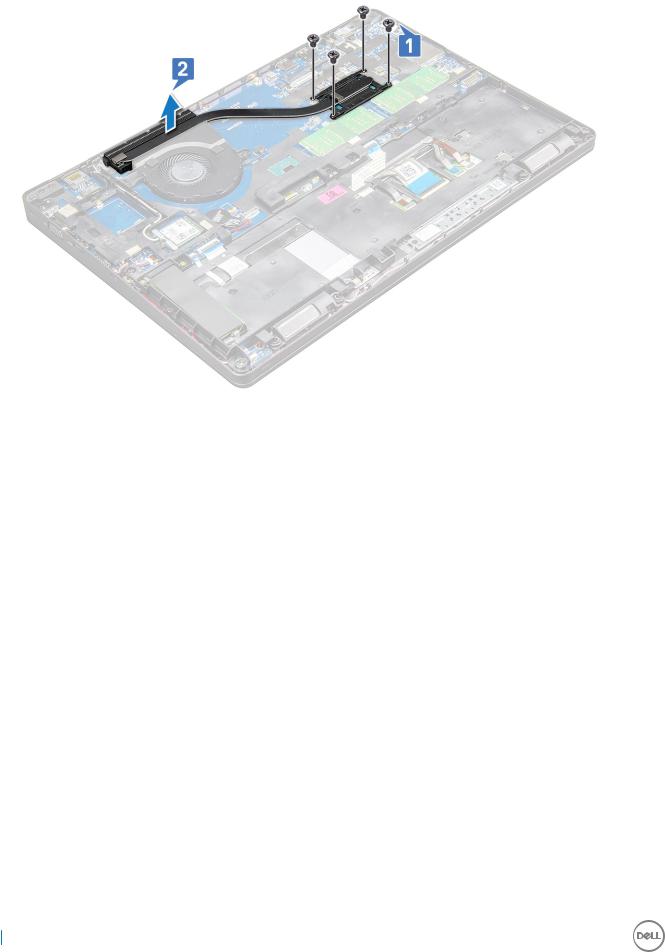
Installing the heat sink
1Place the heat sink on the system board and align the heat sink with the screw holders.
2Tighten the M2.0x3.0 screws (2) to secure the heat sink to the system board.
3Connect the heat sink to the connector on the system board.
4Install the:
abattery
bbase cover
5 Follow the procedure in After working inside your computer.
System fan
Removing the system fan
1Follow the procedure in Before working inside your computer.
2Remove the:
abase cover
bbattery
3 To remove the system fan:
aDisconnect the system fan cable from the connector on the system board [1].
bRemove the M2.0x3.0 screws (2) that secures the system fan to the system board [2]
cLift the system fan away from the system board [3].
28 Removing and installing components

Installing the system fan
1Place the system fan on the system board and align the system fan on the screw holders.
2Tighten the M2.0x3.0 screws to secure the heat sink to the system board.
3Connect the fan cable to the connector on the system board.
4Install the:
abattery
bbase cover
5 Follow the procedure in After working inside your computer.
Power connector port
Removing the power connector port
1Follow the procedure in Before working inside your computer.
2Remove the:
abase cover
bbattery
3 To remove the power connector port:
a Disconnect the power connector port cable from the connector on the system board [1].

 NOTE: Use a plastic scribe to release the cable from the connector. Do not pull the cable as it may result in breakage.
NOTE: Use a plastic scribe to release the cable from the connector. Do not pull the cable as it may result in breakage.
bRemove the M2.0x3.0 screw to release the metal bracket that secures the power connector port [2].
cRemove the metal bracket that secures the power connector port [3].
dLift the power connector port away from the laptop [4].
Removing and installing components |
29 |
|
|

Installing the power connector port
1Insert the power connector port into the slot on the laptop.
2Place the metal bracket on the power connector port.
3Tighten the M2.0x3.0 screw to secure the metal bracket to the power connector port on the laptop.
4Connect the power connector port cable to the connector on the system board.
5Install the:
abattery
bbase cover
6 Follow the procedure in After working inside your computer.
Chassis frame
Removing the chassis frame
1Follow the procedure in Before working inside your computer.
2Remove the:
aSIM card module
bbase cover
cbattery
dWLAN card
eWWAN card
30 Removing and installing components
